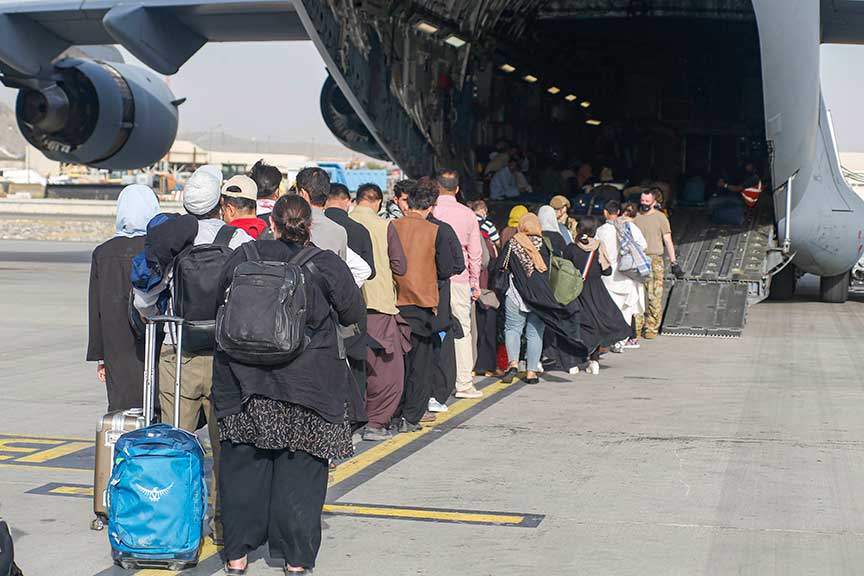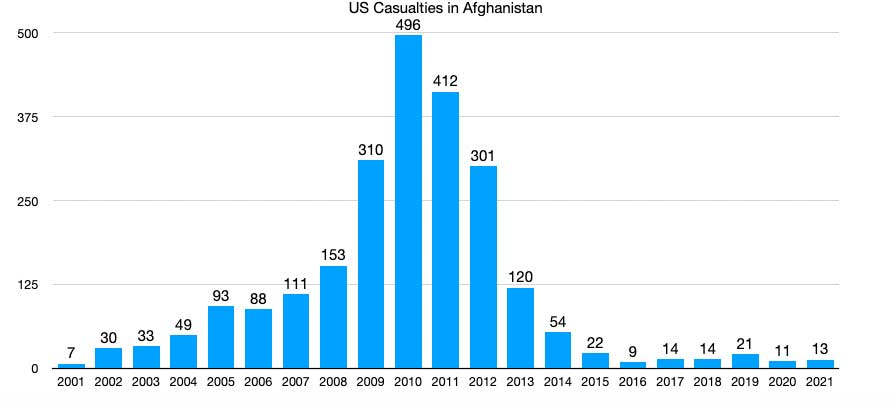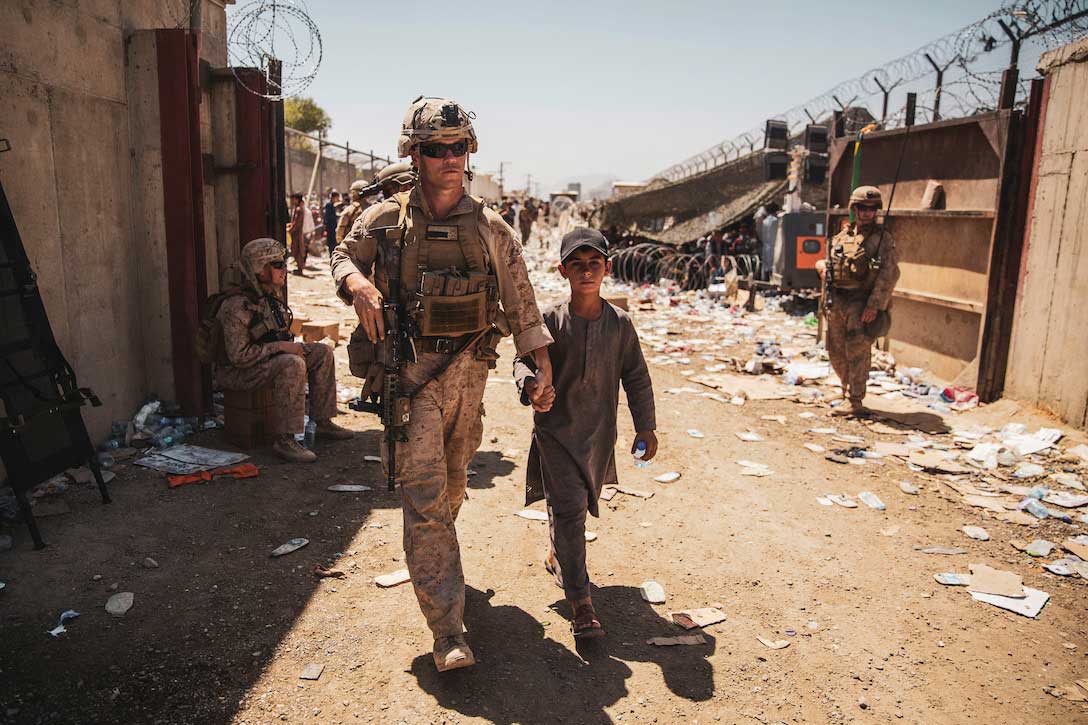Taliban Victorious US Evacuates 122,000

On August 15, 2021 the Taliban completed a lightning victory capturing the Afghanistan capital of Kabul. The United States evacuated its' embassy and started a massive airlift that transported over 122,000 people from Afghanistan.
In the immediate aftermath of the bombing of the World Trade Center and the Pentagon on September 11, 2001, the United States demanded that Taliban leader Mullah Mohammed Omar "deliver to [the] United States authorities all the leaders of al-Qaeda who hide in your land." When he refused, U.S. officials began implementing a war plan.
The U.S. began with a covert campaign working with both the Northern Alliance and anti-Taliban Pashtuns. British special forces joined American special forces and CIA operatives.
On October 7, 2001, the covert campaign became overt when the U.S. began a bombing campaign against the Taliban.
On November 13, the forces of the Northern Alliance marched into Kabul.
In the waning days of November 2001, Taliban leaders began to reach out to Hamid Karzai, who would soon become the interim President of Afghanistan: They wanted to make a deal.
"The Taliban were completely defeated; they had no demands, except amnesty," recalled Barnett Rubin, who worked with the United Nations' political team in Afghanistan at the time.
But the U.S. said no.
On December 6, 2001, Kandahar, the largest city in Southern Afghanistan, fell, which effectively ended Taliban control of the country.
The U.S. then launched a major campaign to find Osama Bin Laden. He was thought to be in the border area with Pakistan. In December 2001, Afghani troops attacked Bora Bora, but Bin Ladin slipped away.
In March 2002, a significant battle took place called operation Anaconda in the eastern province of Paktia. It was the first battle that included forces from other Nato countries.
It had looked like a victory had been reached. Then, on May 1, 2003, U.S. Secretary of Defense Donald Rumsfeld announced an end to "major combat" in Afghanistan.
There were at the time 8,000 US troops in Afghanistan. On October 9, 2004, the first free election was held, and 80% of resisted voters voted to elect Hamid Karzai to become Afghanistan's President. However, Karzai was considered a weak leader, and corruption hampered efforts at nation-building.
The Taliban reemerged in 2005, this time copying the actions of the insurgents in Iraq. However, instead of directly attacking U.S. troops, they relied on suicide bombers and IEDs (improvised explosive devices). Between January 2005 and August 2006, Afghanistan endured 64 suicide attacks. Those attacks continued to worsen. In November 2007, 70 people, including many children, were killed in Baghlan.
President Obama had campaigned to end the bad war (Iraq) and pay more attention to the good war in Afghanistan. On February 17, 2009, he approved sending an additional 17,000 U.S. troops, on top of the 36,000 U.S. troops and 32,000 NATO service members already there. The goal of the surge was to provide enough troops to gain control of territories in Afghanistan and to convince Taliban fighters to switch sides. The surge began in early 2010 with a victory over the Taliban in the Marja part of the Southern province of Helmand. However, Obama's initial increases were not enough to achieve the goal, and soon there were 100,000 troops in Afghanistan. The Obama Administration and the Afghan government tried to hold talks with the Taliban, but they did not get anywhere.

The surge in troops resulted in a significant increase in U.S. casualties, 496 killed in action in 2010 and 412 in 2011.
In May of 2011, U.S. forces found and killed Osama Bin Laden, the terrorist leader behind the 9/11 attacks on the U.S. He was in Pakistan.
Obama announced in June of 2011 that U.S. forces would begin a phased withdrawal, including 30,000 soldiers, by the end of the year.
By this time, there were tensions between U.S. forces and the Afghanis overnight raids as well prisoners. The U.S. government and the Afghani government reached Agreements in March and April 2012 that addressed both issues. In May 2014, an agreement was reached that specified that the U.S. and NATO would continue to support the Afghan government after combat troops left in 2014. In late September 2014, Ashraf Ghani was inaugurated as the new President. He signed the Bilateral Security Agreement that President Karzai had not been willing to sign. Under its terms, the U.S. and NATO formally ended their combat mission in Afghanistan on December 28, 2014, but retained a reduced force of approximately 13,000 troops to support and train Afghan troops.
The Trump administration in February 2020 negotiated a withdrawal agreement with the Taliban that excluded the Afghan government; under the terms of the agreement, the Afghan government was forced to free 5,000 imprisoned Taliban soldiers and set a date certain of May 1, 2021, for the final withdrawal. In addition, part of the agreement that Secretary of State Mike Pompeo negotiated called for the Taliban to break all ties with Al Qaeda.
The Trump administration kept to the pact, reducing U.S. troop levels from about 13,000 to 2,500, even though the Taliban continued to attack Afghan government forces and welcomed al-Qaeda terrorists into the Taliban leadership.
When President Joe Biden became President, he halted the withdrawal temporarily, and after a review, set a new date: September 2021 for the complete withdrawal.
Starting in May 2021, as the U.S. and NATO troops withdrew, the Taliban stepped up their assaults.
On May 8, 2021, a bomb went off at a school in Kabul, killing 85 primarily students. During the course of the month, the U.S. withdrew from one of the largest airbases in Kandahar.
The Taliban seize districts in the northern provinces forcing the government to withdraw. On June 22, the Taliban took the border crossing at Shir Khan Bandar that controls the border with Tajikistan.
On July 2, the U.S. and NATO withdraw from Bagram airbase, which has been the center of U.S. activities in the country. Then, ON July 9, the Taliban capture Islam Qala, the largest border crossing with Iran. That is followed on July 14 by the capture of Spin Boldak, a crossing point into Pakistan.
On August 6, the Taliban assassinate the head of the government media center in Kabul. On the same day, they capture their first provincial capital, the city of Zaranj, without a fight.
On August 8th and 9th, the provincial capitals of Kunduz, along with Sheberghan, Sar-e-Pul, Taloqan, Aibak, and Farah, all fall to the Taliban.
On August 11, Faizabad and Pul-e-Khumri were also captured by the Taliban. Finally, on August 12, the Taliban capture Ghazni and Herat.
On August 13, the southern city of Kandahar is captured without a fight by the Taliban.
On August 14, Asadabad, Gardez, and Mazar-i-Sharif all fall to the Taliban again without a fight.
On Sunday morning, August 15, Jalalabad is taken over by the Taliban. That left just Kabul. In mid-morning, Afghani President Ghani flees the capital and the country.
With Ghani gone, Afghan security personnel seemingly disappear from the capital. The Taliban give the U.S. the option of maintaining security in the capital, but the U.S. choose to reach an agreement to let the Taliban occupy Kabul. General Kenneth F. McKenzie Jr., Commander, United States Central Command, had met Taliban leaders in Qatar to secure an agreement in which the Taliban gave the U.S. assurance that it could maintain the airport for evacuation of American, foreign nationals, and Afghani until August 31.
The U.S. immediately began to evacuate its embassy in downtown Kabul. The U.S. used both helicopters and a land convoy to the airport. At the same time, the U.S. took complete control of Hamid Karzai International Airport, with the U.S. airforce taking over air traffic control. The U.S. also sent in 6,000 additional troops to maintain control of the airport. Initially, there were chaotic scenes at the airport with crowds assembling on the runway. In a symbolic picture of the events, a C-17 was mobbed with people who tried to stop the plane from leaving them behind. Two young people climbed into the wheel hub and later fell to their death as the plane ascended.

Baby born aboard C-17 after leaving Aghanistan
After a day of chaos in which all flights were halted, on August 17, evacuation flights resumed. Within a few days, dozens of large transports were landing daily, and by August 23, the allies reached over 21,000 evacuees in one day.
On August 26, suicide bombers from ISIL-K exploded a bomb by the Abbey Gate of the airport. 13 U.S. service members were killed, and 18 were wounded. In addition, over 130 Afghans were killed and 150 wounded.

By August 29, evacuations began to wind down, with the British ending their efforts that day. On August 30, the U.S. flew its last evacuation flights and evacuated the U.S. soldiers that had been brought in to provide security. Among the last to be evacuated were Afghani security personnel, and their families that had been working with the U.S. were flown out. In total, over 122,000 people were evacuated from the airport in the two-week effort. The last person to board the last C-17 was Major General Chris Donahue, commanding general of the 82nd Airborne Division. At 11:59 PM local time, the C-17 was airborne. The war was over.2,361 Americans had given the ultimate sacrifice, and when it was over, the Taliban were once again in control of Afghanistan.
 >
>